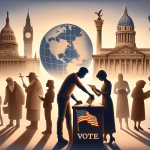Types Of Power
Power is the ability to influence others and make things happen. In organizations, power is distributed among individuals and groups, and it is used to achieve goals and objectives. There are different types of power, and each has its own strengths and weaknesses. Understanding the different types of power can help individuals and organizations use power more effectively and ethically.
Forms of Power in Organizations can be categorized into two types: formal and informal. Formal power is based on an individual’s position in the organization, such as a manager or supervisor. Informal power is based on personal characteristics, such as expertise, charisma, or reputation. Both types of power are important in organizations, and they can be used to influence others and achieve goals.
The Five Bases of Power are legitimate, reward, coercive, referent, and expert power. Legitimate power is based on an individual’s position in the organization, such as a manager or supervisor. Reward power is based on an individual’s ability to provide rewards, such as bonuses or promotions. Coercive power is based on an individual’s ability to punish, such as through demotions or terminations. Referent power is based on an individual’s personal characteristics, such as charisma or reputation. Expert power is based on an individual’s knowledge or expertise in a particular area.
Key Takeaways
- Power is the ability to influence others and make things happen in organizations.
- There are different types of power, including formal and informal power.
- The Five Bases of Power are legitimate, reward, coercive, referent, and expert power.
Forms of Power in Organizations

Organizations are structures that require power to function effectively. Power is the ability to influence others and make decisions that impact the organization. There are two main forms of power in organizations: Formal Power and Personal Power.
Formal Power
Formal power is derived from an individual’s position within the organization’s hierarchy. It is also known as positional power or authority. The formal power is vested in the individual by the organization, and it gives the individual the right to make decisions and take actions that affect the organization.
Formal power is usually associated with leadership positions such as managers, directors, and executives. The higher an individual’s position in the organization, the more formal power they have. Formal power can be further divided into three types:
-
Legitimate Power: This is the power that comes from an individual’s position in the organization’s hierarchy. It is the power to give orders and expect them to be obeyed.
-
Coercive Power: This is the power to punish or threaten to punish others for not following instructions.
-
Reward Power: This is the power to reward others for following instructions or meeting performance targets.
Personal Power
Personal power is derived from an individual’s personal qualities and characteristics. It is also known as referent power or expert power. Personal power is not vested in an individual by the organization, but rather, it is earned through personal qualities such as knowledge, expertise, and charisma.
Personal power is usually associated with individuals who have a high level of expertise in a particular field. For example, a software developer who is an expert in a particular programming language may have personal power within the organization.
Personal power can be further divided into two types:
-
Expert Power: This is the power that comes from an individual’s knowledge, skills, and expertise in a particular area.
-
Referent Power: This is the power that comes from an individual’s personal qualities such as charisma, likeability, and trustworthiness.
In conclusion, organizations require both formal and personal power to function effectively. Formal power is derived from an individual’s position within the organization, while personal power is derived from an individual’s personal qualities and characteristics. Understanding these forms of power is essential for effective leadership and decision-making in organizations.
The Five Bases of Power
Power is a crucial aspect of leadership that enables a leader to influence and motivate their followers towards achieving organizational goals. French and Raven identified five bases of power that leaders use to influence their subordinates. These bases of power include legitimate power, reward power, coercive power, expert power, and referent power.
Legitimate Power
Legitimate power is derived from the formal position of a leader in an organization. It is the power that comes with the position and is therefore ascribed. Legitimate power is based on the belief that it is natural for a leader to make demands while expecting others to obey and comply with these demands. Legitimate power is the most common form of power used in organizations, and it is often used to gain compliance.
Reward Power
Reward power is the power to provide rewards or incentives to motivate followers to comply with the leader’s requests. Rewards can be in the form of salary increases, promotions, bonuses, or other benefits. Reward power is based on the belief that people are motivated by rewards and that they will comply with requests if they believe that there is a reward waiting for them.
Coercive Power
Coercive power is the power to punish or penalize followers for non-compliance. It is based on the belief that people are motivated by the fear of punishment and that they will comply with requests if they believe that there is a punishment waiting for them. Coercive power is often used to gain compliance in situations where other forms of power have failed.
Expert Power
Expert power is the power that comes from having specialized knowledge or skills that are valued by others. It is based on the belief that people will comply with requests if they believe that the person making the request has specialized knowledge or skills that are necessary for success. Expert power is often used in situations where the leader has more knowledge or skills than their followers.
Referent Power
Referent power is the power that comes from being respected, admired, or liked by others. It is based on the belief that people will comply with requests if they believe that the person making the request is someone they respect, admire, or like. Referent power is often used in situations where the leader has a close relationship with their followers.
In conclusion, understanding the five bases of power is crucial for effective leadership. Leaders who are aware of these bases of power can use them to influence their followers positively. Leaders who use the right bases of power can motivate their followers to work towards achieving organizational goals, while those who use the wrong bases of power can demotivate their followers and lead to organizational failure.
Influence and Leadership
Effective Leadership
Effective leadership is about inspiring and motivating others to achieve a shared goal. It requires a combination of skills, including communication, delegation, decision-making, and problem-solving. Effective leaders are those who can create a vision, set goals, and inspire their team to achieve them. They also have the ability to influence others and create a positive work environment.
One of the most important aspects of effective leadership is the ability to motivate others. A great leader can inspire their team to achieve great things by creating a sense of purpose and direction. They can also provide support and guidance to help their team members develop their skills and reach their full potential.
Leadership Styles
Leadership styles can vary depending on the situation and the individual leader. Some leaders are more authoritarian, while others are more collaborative. Each style has its own strengths and weaknesses, and effective leaders are those who can adapt their style to suit the situation.
Charisma is another important aspect of leadership. Charismatic leaders have a natural ability to inspire and motivate others. They have a strong presence and can command attention and respect. However, charisma alone is not enough to make a great leader. It must be combined with other skills, such as communication and decision-making.
Effective leaders also understand power dynamics and how to use them to their advantage. They know how to build relationships and influence others, while also being mindful of the needs and interests of their team members. They are also great at delegating tasks and responsibilities, which helps to build trust and accountability.
In conclusion, effective leadership is about inspiring and motivating others to achieve a shared goal. It requires a combination of skills, including communication, delegation, decision-making, and problem-solving. Great leaders also have the ability to influence others and create a positive work environment.
Power Dynamics and Employee Relations
Power dynamics in the workplace can have a significant impact on employee relations. Understanding the different types of power and how they are used can help employers create a positive work environment and improve employee engagement.
Cultural and Social Power
Cultural and social power refers to the influence that individuals or groups have within a specific culture or social group. This type of power can be used to motivate employees to work towards a common goal, or to identify with the values and beliefs of the organization.
In order to effectively use cultural and social power, employers must create a positive work culture that aligns with the values and beliefs of their employees. This can be achieved by providing opportunities for employees to participate in decision-making processes, recognizing and rewarding employee achievements, and promoting open communication between management and employees.
Informational Power and Compliance
Informational power refers to the ability to control information and use it to influence the behavior of others. This type of power can be used to encourage compliance with organizational policies and procedures, or to motivate employees to work towards specific goals.
Employers can use informational power to promote compliance by providing clear and concise information about organizational policies and procedures, and by ensuring that employees understand the consequences of non-compliance. This can be achieved through training programs, disciplinary action, and other methods that promote compliance and encourage employee engagement.
Overall, understanding power dynamics in the workplace is essential for creating a positive work environment and improving employee relations. By using cultural and social power to motivate employees and informational power to promote compliance, employers can create a work environment that encourages employee engagement and promotes organizational success.
Power Beyond the Workplace
While power dynamics are often most visible in the workplace, power also exists in society and international relations. Here are some examples of power beyond the workplace:
Power in Society
In society, power can take many forms, including formal authority, wealth, celebrity status, and the ability to influence public opinion. Government officials, for example, hold formal authority and have the power to make decisions that affect the lives of citizens. Wealthy individuals and celebrities have the power to shape cultural norms and influence public discourse.
Masses of people can also wield power through collective action, such as protests and boycotts. Social movements have historically been a powerful force for change, from the civil rights movement to the #MeToo movement.
International Power Structures
In international relations, power is often measured in terms of military strength, economic influence, and diplomatic clout. States with strong militaries have the power to project force and protect their interests abroad. Economic powerhouses like China and the United States have the ability to shape global trade and investment patterns.
International organizations like the United Nations and the World Trade Organization also play a role in shaping international power structures. These organizations provide a platform for countries to negotiate and cooperate on issues like climate change, human rights, and trade policies.
Overall, power dynamics are complex and multifaceted, extending far beyond the workplace. Understanding the different types of power and how they operate in various contexts can help individuals navigate and influence these dynamics.




